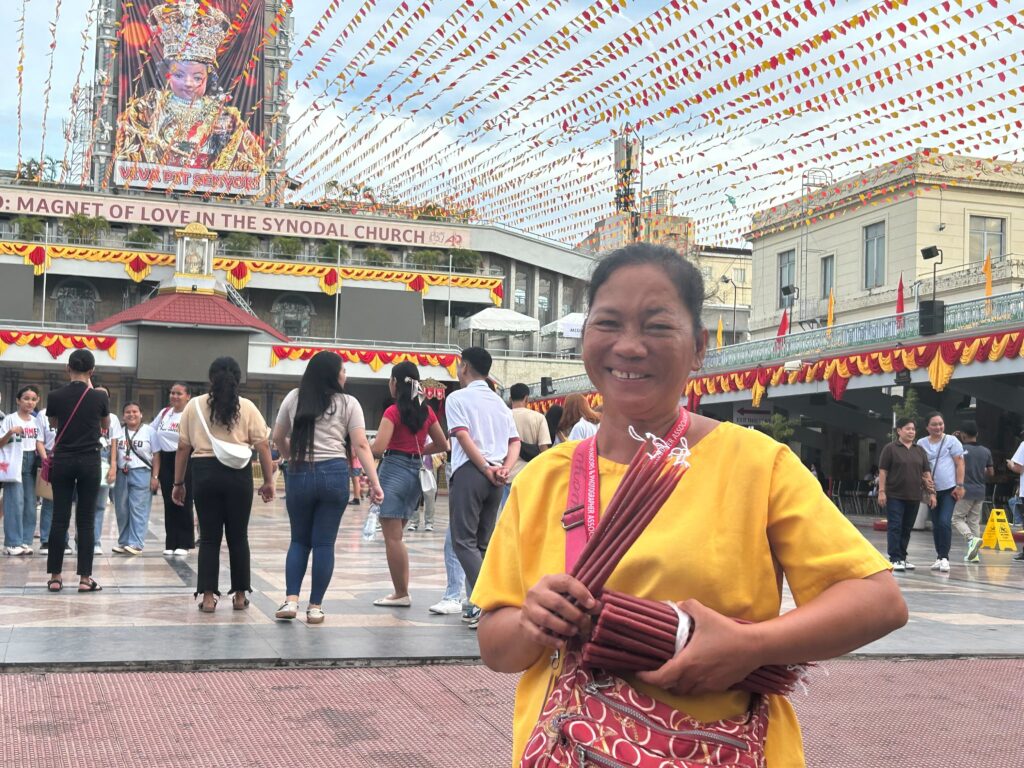
Geaseth Dela Fuente, a 46-year-old candle vendor at the Basilica Minore del Sto. Niño. CDN Digital photo | Pia Piquero
CEBU CITY, Philippines – Candles have long been revered as symbols of hope among devotees at the Basilica Minore del Santo Niño.
Whether you are a visitor in the sacred halls or among the vendors, the candle transforms into more than just an offering for prayers; it becomes a vessel for conveying your aspirations and life intentions.
As candles assume the role of vessels, there are individuals who emerge as the driving force behind each one, tirelessly working to ensure that our prayers find fulfillment – the tig-Sinug candle vendors.
READ MORE: FACES OF CEBU: Danica Caballes, original voice behind ‘Daghang Salamat, O Santo Niño’
Geaseth Dela Gente, a 46-year-old, is among the many tig-Sinug candle vendors inside the Basilica Minore del Santo Niño.
“Tig tabang mi og unsay gipangayo sa mga tawo na mosulod diri sa (Basilica). Tig tabang mi sa ilang wishes ug unsay (ilang) pangayoon (nga matuman),” Geaseth said.
(We help those who have petitions here at the Basilica. We help them with their wishes and what they ask for.)
The tig-Sinug candle vendors not only sell candles but also often perform a dance prayer, holding unlit candles that bear the solemn intentions of the buyers. This tradition is known as “Sinug.”
The ‘Sinug’ dance
The traditional “Sinug” dance is quite simple: Two steps forward, one step backward. The dancer slightly sways to the rhythm of the music in her mind and her heartbeat, as she murmurs the petition sought by the candle buyer.
However, Geaseth typically does not perform the dance steps; instead, she vocalizes the petition and prayer aloud while holding the candles.
READ: 3 basic steps for 6M people
Geaseth has dedicated six years to helping numerous visitors in the Basilica. She has assisted students by helping them pray for their board exams, job applications, and visa processes, ensuring their approval to go abroad.
“Mupalit sila og kandila namo, mao nay gamiton namo sa ilang wishes… Depende raman pod na sa ampo og kinasing kasing ba,” she noted.
(They buy candles from us, that’s what we use for their wishes… It also depends on the prayer, if it’s wholeheartedly.)
Candle vendor Geaseth Dela Gente teaches a child to do the ‘Sinug’ dance. CDN Digital photo | Pia Piquero
According to Geaseth, what they were doing is a long-standing tradition dating back to when her mother was still around.
Geaseth, before becoming a candle vendor, was a homemaker, caring for her mother, who, too, was engaged in the candle vending job in Basilica.
“Kami sauna magtan aw mi niya unsaon pagluto [og kandila] hangtod nakat-on mi unsaon pagluto aron siya, inag uli gikan dinhi, makapahuway na siya,” Geaseth said.
(Before, we watched her make candles until we learned how to do it so she, when she went home from selling, could rest.)
Continuing the ‘Sinug’ tradition
Geaseth’s mother devoted more than 30 years to the candle-selling trade at the Basilica. She was among the seasoned tig-Sinug candle vendors in the church.
However, when her mother passed away, Geaseth mentioned that her mother left a bequest that one of her children must continue the tradition of Sinug in Basilica.
A year after her mother’s passing, and with none of her siblings willing to take on the responsibility, she decided to assume the role her mother had left behind.
Taking on the role of her mother as a candle vendor in the Basilica, she came to realize that candles held not only symbolic significance but also required a genuine association with sincerity for prayers to come true.
READ MORE: LOOK: Schedule of Novena Masses of Fiesta Señor 2024
“Ang symbolo sa kadila, makatabang ni para ilang mga gipangayo matuman. Bisan pila ra gud ang kandila basta ang pag ampo kinasing-kasing,” Geaseth said.
(The symbol of the candle is to help one’s prayer be heard. No matter how much candles you buy, the important thing is the prayer is done wholeheartedly.)
In her six years, she has testified that most of the visitors she helped have come back to thank her because she was able to help them fulfill their prayers.
For instance, a student whom she helped in praying to pass the Licensure Professional Teachers (LPT) exam succeeded. The student came back to the Basilica and thanked her.
Believer
So does she believe in the Santo Niño?
“Dugay nakong believer ni Santo Niño kay og naa koy i-sinug, dili man sa pagpamhambog pero matinuod baya ilang mga gipa ampo… Sila mismo mo sulti nako na natuman, malipay pod ko,” she said.
(I have been a believer of the Santo Niño for a long time because every time I do a sinug, not to brag but the prayers always get granted. They are the ones who tell me that their answers were answered, and it makes me happy.)
Geaseth observed that the Sinug not only assists individuals seeking help through prayer but has also positively impacted her own life.
READ MORE: Dancing candle vendors of Basilica Minore del Santo Niño: Keeping the ‘Sinug’ dance tradition alive
According to her, she is grateful to Señor Santo Niño because he has never left her and has bestowed upon her the role of being an instrument for people to fulfill their prayers.
“Sto Niño, naa gyud siya perme bisan sa mga pagsuway nga niabot nimo, nato. Naa gihapon siya, wa gyud ko niya pasagdi,” she said.
(The Sto. Niño, He’s always there no matter what trials come to you, to us. He’s always there, He never left me.)
In the hallowed halls of Basilica Minore del Santo Niño, the tradition of tig-Sinug candle vendors, embodied by devoted individuals like Geaseth Dela Gente, goes beyond a mere exchange of candles.
The stories of fulfilled prayers resonate, marking the enduring significance of tig-Sinug in the hearts of those who partake in this timeless tradition.
/bmjo